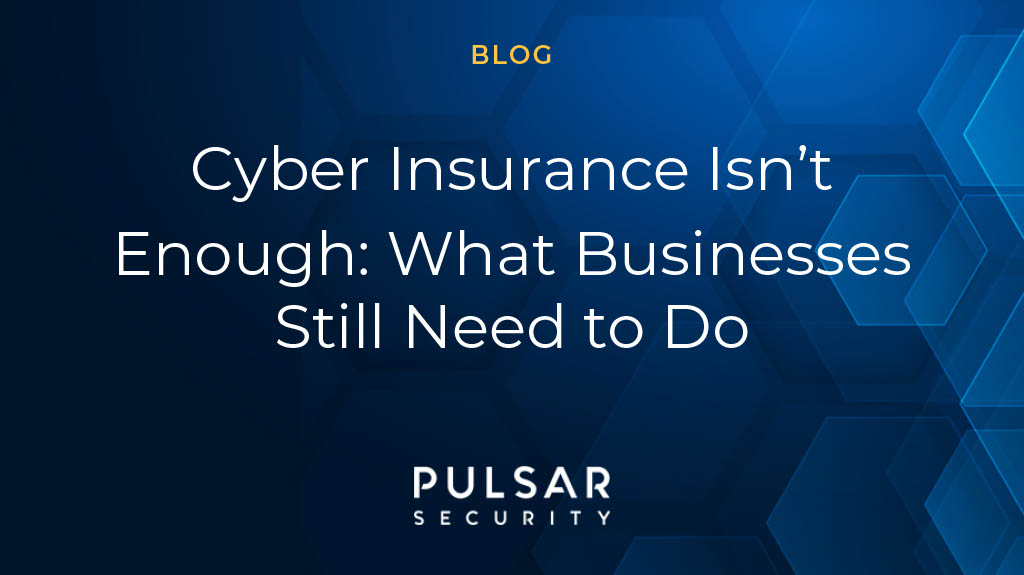Cyber Insurance Isn’t Enough: What Businesses Still Need to Do
Cyber insurance provides an additional layer of protection against financial losses and liability in the event of a data breach.
But for enterprises, the real question is whether such an investment-which could run thousands of dollars-is justified over and above the other measures they may take to secure themselves against cyber threats.
Many organizations decide whether to purchase cyber insurance by weighing the potential financial impact of a breach against the cost of premiums.
What does it mean to have a cyber insurance coverage?
Certainly, there are advantages gained when organizations purchase cyber liability insurance; here are the major three:
- Monetary Insurance: Coverage in case of financial loss as a result of a data breach.
- Regulatory Assurance: Showing due diligence to the regulatory bodies by maintaining the standards in the industry.
- Stakeholder Confidence: Giving confidence to the organization and all its stakeholders.
However, this peace of mind afforded by a cyber insurance premium does not come overnight. First, a company has to go through a really intensive underwriting process before getting to active policy underwriting. Insurers will take a close look at the organization’s cyber risk profile and price it, setting policy limits in respect of identified risks. In order for businesses to qualify, they must demonstrate robust security controls, adhere to established frameworks, and pass audits, which means that not all companies can secure cyber insurance coverage.
What’s more, cyber liability insurance may mitigate most of the financial costs, but it does not give organizations a free-for-all license to ignore all implications of a data breach. Organizations still have to remain proactive about cybersecurity in their attempt to reduce risk and remain insurable.
Undoubtedly, cyber insurance alone is insufficient and often expensive
Even though the National Association of Insurance Commissioners and the Federal Trade Commission encourage businesses to consider cyber insurance as one way to protect against cyberattacks, a mere recommendation is not sufficient.
Furthermore, there is a need for policymakers to work to make cyber insurance products available and affordable, especially for small businesses that might have limited resources.
However, that is only part of the equation. Most importantly, businesses must reduce cyber risk through preventive measures, which enhance their security posture and keep insurance premiums within reasonable levels.
The digital age provides immense opportunities but also exaggerates the frequency and potential magnitude of cyber threats. As a result, it is not about having insurance but building a comprehensive and proactive cybersecurity approach that will supplement insurance as financial security, should this happen.
Ultimately, although cyber insurance is considered a key component of risk management, it is not a complete solution to all cybersecurity issues. Rising premium costs, coupled with higher policy conditions, aggravate the problem.
The Insurance Information Institute reports that direct written premiums for cyber insurance could surge to $23 billion by 2025. Two major influential factors are driving this current state.
- Escalating Threat of Cyberattacks: Data breaches and cyberattacks have long posed serious challenges for businesses. However, the growing reliance on IoT technologies, the expansion of remote work, and the increased use of cloud storage have significantly heightened the exposure of U.S. companies to modern cyber threats.
- Clarity in the Policy and Underwriting: Insurers have done a lot in refining the borders of what policies cover and what they do not, in turn helping risk managers understand the value of cyber insurance. It has also helped insurers contain costs and maintain stable rates. Improved underwriting and good policy wording mark evidence in the way the industry tries to keep pace with an ever-somewhat complex risk environment. However, in spite of all these developments, the challenges for insurers will never disappear. The lack of sufficient data on the number of attacks and breaches results in a rather restricted ability to anticipate and manage liabilities. This has driven an increased call for more comprehensive collection and analysis of data for underwriting, enabling a path toward sustainable coverage within a fast-evolving cyber risk landscape.
Moreover, insurers are getting picky, with reports of policy non-renewals or outright cancellations on the increase, making more sense for businesses to invest in substantial preventive cybersecurity to reduce the risk profile and maintain insurability.
Even for those who can afford it, cyber insurance falls woefully short of comprehensive. Most policies protect against named risks only and not against all security breaches. In practice, this simply translates into very constrained policy scope, leaving the policyholder exposed to gaping voids should they be uninformed about exclusions and other coverage nuances.
The exclusion typically would relate to all those cyber insurance policies that are caused due to cyber terrorism, state-sponsored attacks, intellectual property violations, or contractual agreements. Events that come under bodily injury, war, terrorism, or property damage also usually come under exclusion. Moreover, deductibles, co-payments, and sub-limits may also form part of such policies, which would further lower the actual coverage on claims.
These are generally not recognized by unsophisticated buyers, who may later be disappointed if and when a breach occurs. Corporations need to get the terms of such policies reviewed by a competent and qualified adviser. The coverage fits within the particular risk profile and business need.
Here is how you can address the challenges of insufficient cyber insurance
1. Better Risk Assessments
In themselves, comprehensive risk assessments have become an important step toward understanding the sets of vulnerabilities within an organizational infrastructure. The processes involve internal and external scanning to find weaknesses in systems, applications, and networks that would allow organizations to systematically map them out and come up with a prioritized plan for remediation, thus reducing their exposure to cyber threats. It also provides insight into how an attacker can use such weak points, hence saving much in putting up a better and focused response towards security.
Besides, proactive handling of risk drastically reduces the events of a breach, and as such, there would be less dependence on limited cyber insurance coverage.
2. Invest in Penetration Testing
Penetration testing allows an organization to simulate real cyberattacks, aiming to detect vulnerabilities in systems that could potentially be leveraged. Such practical means of testing are highly important for revealing weaknesses before malicious actors may find them.
Examples include network and web application penetration tests, which check how well firewalls, encryption, and other security technologies will stand up to simulated attacks.
Consistent investments in penetration testing allow enterprises to quickly fix security gaps and further improve their posture in the context of cyber threats. It strengthens not only the company’s defense but also points toward the best practice of proactive cybersecurity, which will be so crucial to the issues of risk management and compliance.
3. Implement Robust Security Frameworks
There is a pressing need for strong cybersecurity frameworks that protect against modern cyber threats. The policies should include network monitoring and access control, as well as regular patch management policies. For instance, wireless network monitoring tools can track unauthorized access and other anomalies in real time. In addition, software and hardware should be kept up-to-date with the latest patches since most of the attacks target those systems that remain unpatched. One that is robust won’t just reduce the immediate threat; it will have a security culture in place where every team member in the organization knows their part of the cybersecurity cycle.
4. Train Employees
Employee mistakes remain one of the most common causes of data breaches; thus, broad training is essential in any cybersecurity approach. Organizations should provide training on how to recognize phishing attempts, use robust passwords, and increase sensitivity toward the handling of data.
Cybersecurity awareness can be further instilled by periodic phishing simulation training that would help employees recognize and try to avoid certain possible scenarios.
Eventually, companies can decrease the possibility of human error causing a breach by creating a knowledgeable workforce, filling an important gap that may not be covered in cybersecurity insurance. Educated employees serve as another layer of protection against possible cyberattacks.
5. Leverage Threat Monitoring Services
Real-time threat monitoring is all about identifying risks and mitigating them when they actually occur at an instance. The sophisticated solution of threat monitoring can trace irregular activities across networks, applications, and endpoints, allowing time for immediate responses against impending breaches.
Examples include the following: Pulsar Security monitors unauthorized access or suspicious file transfers and provides timely notifications in real time to security teams. This capability is good because it portends the identification and confinement of risks before they become serious incidents.
Investment in continuous monitoring is bound to help an organization strengthen its capability to respond effectively against cyber threats, thus reducing reliance on insurance claims.
6. Improve Your Data Protection Policy
The set of mitigants most relevant to cybersecurity would probably include comprehensive data protection policies developed and kept up to date. It would involve a process that concerns the protection of sensitive information, breach response, and compliance actions with regulatory requirements. Quite obviously, it would require periodic audits and updating since threats are always changing. A good policy might include requirements for encryption of sensitive data and possibly limitations on sharing safe data.
Well-published policies and, at least, their awareness and adherence reduce the probability of a breach. After all, due diligence may be demonstrated to get better terms for cyber insurance.
About Pulsar Security
Cyber insurance is just one piece of the puzzle. At Pulsar Security, we help organizations reduce cyber risk at the source—with expert-led vulnerability assessments, penetration testing, security framework implementation, and continuous threat monitoring. Our mission is to strengthen your security posture, improve insurability, and ensure you’re prepared long before an incident occurs. Learn more at pulsarsecurity.com.

Corey Belanger
Corey is a Security Consultant and leads QA of product development, using his expertise in these dual roles to more effectively test and secure applications, whether while building enterprise applications or while performing penetration tests and vulnerability assessments for customers. An Army veteran with a tour of duty in Afghanistan, Corey has built a post-military career in security while earning Network+, Security+, GIAC Certified Incident Handler, GIAC Python Coder, GIAC Web App Penetration Testing, and GIAC Penetration Tester certifications. Corey is also a BsidesNH organizer and founding member of TechRamp, avenues which he uses to help others build their skills for careers in security and technology. Fun Fact: When not manning a terminal or watching the Bruins, Corey can often be found snowboarding or riding his motorcycle.




